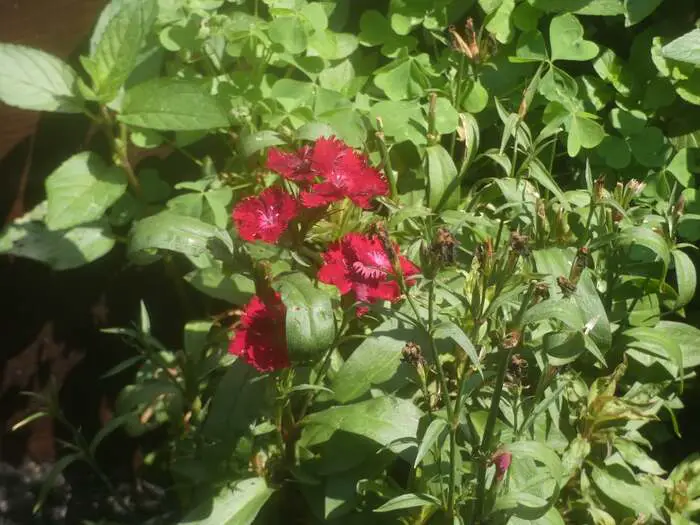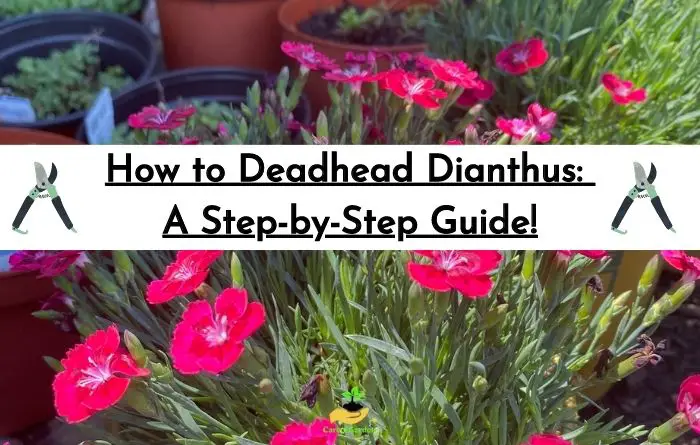How to Deadhead Dianthus: A Step-by-Step Guide!
The removal of dianthus faded flowers, known as deadheading, is a task that every gardener needs to know how to perform. By doing so, you can encourage new growth and extend the blooming period of your plants. In this blog post, we’ll show you how to deadhead dianthus in just a few easy steps.
How to Deadhead Dianthus
If you want your dianthus plant to grow more flowers and look more beautiful, you have to deadhead them very carefully.
Tools you need:
- Gardening shears
- Scissors
Step 1: Prepare your tools
You won’t need many tools for deadheading Dianthus. Gather a pair of clean and sharp pruning shears or garden scissors. Make sure they are sanitized to prevent the spread of diseases.
Step 2: Identify Wilted Flowers
First, you need to look for the wilted flowers, and you have to make sure that they are detached from the bud of the flower.
Examine each flower and stem systematically and cut off any flowers that have died, lost their bright color, or have begun to wilt and brown. Cut the flowers off 1/4-inch above the closest set of healthy leaves.
Snipping the flowers off at this point stimulates the plant to focus on growing a bright new bloom instead of new leaves. Removing dead flowers encourages other flowers to bloom for a longer period of time.
Step 3: Choose the Right Time
The best time to deadhead Dianthus is after the initial flush of blooms has started to fade. It’s usually during the late spring or early summer when the first round of flowers begins to wither.
Cutting the dianthus plant once it is nearly full bloom, usually six weeks after the first bloom of the season.
Cut off any dead flowers before they form seed in the inner pod of the flower head. Trimming the dead flowers at the right time prevents the dianthus from self-seeding as well as supporting vigorous root development, which proves beneficial when dividing the plant.
Step 4: Trim the Faded Flowers
Now, carefully prune the dead part from above the dianthus leaves. Avoid pruning leaves as they are important for the life of the plant.
Using garden shears, cut the leaves back down to 5 inches to keep the strong shape in the bush, however, for year-round showy evergreen foliage, cut no more than 3 inches. The dianthus plant tolerates trimming back to soil level as needed.
Using your pruning shears or scissors, make a clean cut just above the leaves or buds at a 45-degree angle. This angle helps prevent water from pooling on the cut, which could lead to rot.
You can also use scissors to cut the dianthus dead ends. These dead buds are very easy to get rid of with the help of the proper tools.
Step 5: Remove all Wilted Flowers
Continue to inspect the dianthus and deadhead all the faded flowers using the same method described in Step 4.
Harvest the dianthus seeds after they leave the pods, lodged within the wilting flower, on the plant until the pods turn brown.
Snip off dead pods and flowers with shears or scissors once they are completely dry, at which time the seeds will easily fall out when shaken.
Although the plant will look scruffy and bumpy for a few weeks, the resulting seeds will provide a solid foundation for propagation in subsequent years.
Step 6: Cut the Dianthus Stem
Stem cutting is also very important. It is an even more delicate process. First, you have to make sure that no other flower is growing on it. For this, the best course of action is to look from the top and see if there are any lateral flowers.
Lateral flowers are newly grown flowers below the main flower and are usually very soft. You can cut right above the lateral ones. Cutting stems at the right point ensures the growth of new stems in a more organized and beautiful manner.
Other than shearing and pruning, some techniques do not require any kind of tool.
These methods include:
- Pinching: in which you pinch the dead or unwanted part in between your thumb and index finger
- Snapping: in which you snap harder to break the stem from the desired place. This often works on long-stemmed plants.
Step 7: Water and Care
After deadheading, water the Dianthus plant appropriately and continue to care for it as usual, providing adequate sunlight, water, and nutrients to encourage healthy growth and new blooms.
Preventions when Deadheading Dianthus:
Here are a few preventive steps that you must take while deadheading your dianthus plants:
- First and most important of all is to use the proper tools. If you are using old, worn out and outdated tools, your deadheading might go south. You might experience irregularities in the cutting patterns and even worse; your plants might catch a disease.
- You need to use brand-new pruning tools before deadheading and you must sterilize them with alcohol or spirit.
- Another important thing that people often misunderstand is that if you want more seeds at the end of the season, then there is no need for deadheading. Deadheading is only for the beautification and proper health of the plant.
In an overgrown, dense dianthus situation, the complete energy of the plant is distributed in different partial sections. The main focus is diverted, and energy is consumed in growing flowers, seeds, stems, new growth, and so on.
To get rid of all this, you need to deadhead every stem of the plant and carve it into the desired shape. In this way, your garden, backyard, or plants will bloom and show maximum growth and beauty.
How far down to deadhead dianthus?
When you’re deadheading dianthus, it’s essential to trim the flower stem down to the nearest set of leaves or a lateral flower bud. This encourages continued growth and more blooms.
Cut the stem just above the healthy leaves or flower bud, making a clean cut at a slight angle for proper healing and to avoid water pooling on the surface.
Benefits of Deadheading Dianthus
| Benefits of Deadheading Dianthus |
|---|
| 1.Promotes continuous blooming |
| 2.Extends the flowering season |
| 3.Improves overall plant health |
| 4.Enhances aesthetic appearance |
| 5. Prevents seed production |
| 6.Increases flower production |
| 7.Encourages new growth |
| 8.Maintains a neat and tidy look |
When to deadhead Dianthus?

People are often confused about whether their dianthus plants are ready to be deadheaded or not.
Many signs appear on your dianthus, which show that deadheading is needed. The period is usually between June to September but it varies from type to type.
Signs when to deadhead dianthus include:
- If there are wilted petals;
- If there are fading blooms;
- If there are unwanted growths;
- If the plants are getting denser;
- If the looks are no more attractive and pleasing;
- If there are spent stems of no use;
| Desired Outcome | Timing for Deadheading |
|---|---|
| Promote more blooms and extend the blooming season | Deadhead after the first flush of blooms, when flowers have faded and petals are falling off |
| Encourage bushier growth and more flowers | Deadhead regularly throughout the growing season, as soon as flowers start to fade |
| Allow for self-seeding | Deadhead sparingly, leave some spent flowers on the plant until seed heads have formed and seeds have matured, then cut off stem just below seed head |
Should I Deadhead Dianthus Before or After Flowering?
Deadheading Dianthus can be done both before and after flowering. Here are the pros and cons of each method:
Before flowering:
- Pros: Deadheading before flowering can help promote bushier growth and more flowers, as it encourages the plant to produce more lateral shoots and prevents it from putting energy into seed production.
- Cons: Deadheading before flowering means sacrificing any potential flowers that could have bloomed on the existing stems. Additionally, it can be difficult to tell which stems will produce buds and which ones won’t, so you may end up cutting off some potential blooms.
After flowering:
- Pros: Deadheading after flowering helps to remove spent blooms and prevent seed production, which can divert energy away from the plant’s growth and flowering.
- Cons: If you wait too long to deadhead after flowering, the plant may have already produced seeds and started to die back. This means you’ll miss out on some of the plant’s flowering season.
In the end, the decision to deadhead Dianthus before or after flowering depends on your gardening objectives and personal preferences.
If you want a more abundant and bushier display, deadheading before flowering is a good choice.
On the other hand, if you prioritize removing spent blooms to encourage prolonged flowering, deadheading after flowering is the preferred approach.
Can I Deadhead Dianthus with My Fingers?
Yes, on plants with soft, thin stems like dianthus, deadheading flowers can simply be pinched off with your fingers. To do this, gently pinch the stem just below the spent flower head and snap it off using your fingers. However, if the stems are woody or difficult to snap, it’s better to use scissors or pruning shears instead.
You need to make sure your fingers are clean before deadheading with them, to prevent the spread of disease. If you prefer to use your fingers, you can also wear gloves to protect your hands and keep them clean.
Frequently Asked Questions
Deadheading dianthus is done to remove faded or spent flowers from the plant. By doing so, you encourage the plant to produce more blooms, extend the flowering season, and maintain a neat and tidy appearance.
The frequency of deadheading dianthus depends on the specific variety and its blooming pattern. In general, it is recommended to deadhead every 1-2 weeks or as soon as the flowers start to fade. Regular deadheading will encourage new growth and continuous blooming.
Deadheading is most effective when performed on flowering plants. However, if you notice any discolored or unsightly parts of the plant, you can remove them to maintain the plant’s overall appearance.




